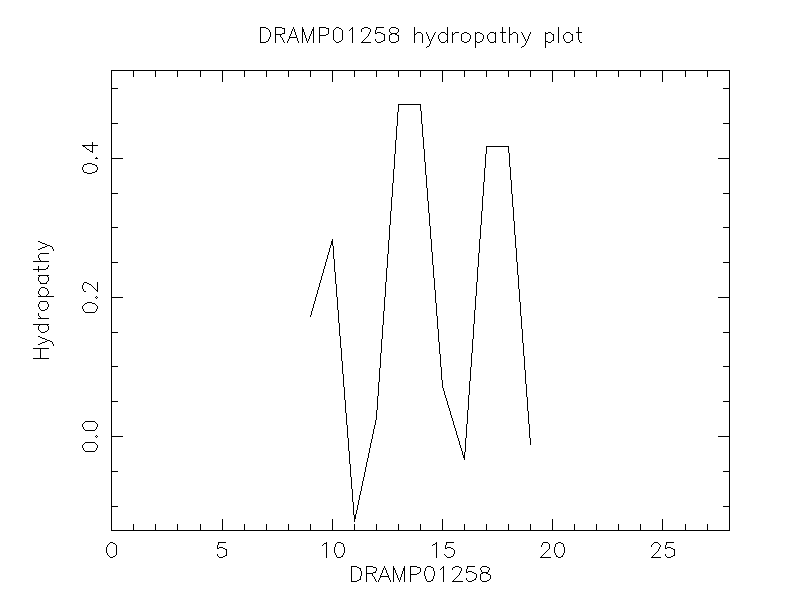General Information
-
DRAMP ID
- DRAMP01258
-
Peptide Name
- Dermadistinctin-L (DD L; Frogs, amphibians, animals)
-
Source
- Phyllomedusa distincta (Monkey frog)
-
Family
- Not found
-
Gene
- Not found
-
Sequence
- ALWKTLLKNVGKAAGKAALNAVTDMVNQ
-
Sequence Length
- 28
-
UniProt Entry
- P83639
-
Protein Existence
- Protein level
Activity Information
-
Biological Activity
- Antimicrobial, Antibacterial, Anti-Gram+, Anti-Gram-, Antifungal, Antiprotozoal
-
Target Organism
-
- [Ref.10477123]Gram-positive bacteria: Staphylococcus aureus (MIC=1.3 µM), Enterococcus faecalis (MIC=10 µM);
- Gram-negative bacteria: Pseudomonas aeruginosa (MIC=40 µM), Escherichia coli (MIC=2.5 µM);
- [Ref.17442605]Fungi: Candida tropicalis (MIC=10.9 µM), Candida guilliermondii (MIC=21.8 µM), Candida albicans (MIC=21.8 µM), Candida albicans ATCC 1023 (MIC=10.9 µM).
-
Hemolytic Activity
-
- [Ref:10477123]Show some hemolytic starting at 12.5 μM against human blood
-
Cytotoxicity
- No cytotoxicity information found in the reference(s) presented
-
Binding Target
- liposomes
Structure Information
-
Linear/Cyclic
- Linear
-
N-terminal Modification
- Free
-
C-terminal Modification
- Free
-
Nonterminal Modifications and Unusual Amino Acids
- Free
-
Stereochemistry
- L
-
Structure
- Alpha helix
-
Structure Description
- Not found
-
Helical Wheel Diagram
-
PDB ID
- None
-
Predicted Structure
- There is no predicted structure for DRAMP01258.
Physicochemical Information
-
Formula
- C130H221N37O37S
Absent Amino Acids
- CEFHIPRSY
Common Amino Acids
- A
Mass
- 2926.47
PI
- 10
Basic Residues
- 4
Acidic Residues
- 1
Hydrophobic Residues
- 14
Net Charge
- +3
-
Boman Index
- -12.3
Hydrophobicity
- 0.154
Aliphatic Index
- 108.21
Half Life
-
- Mammalian:4.4 hour
- Yeast:>20 hour
- E.coli:>10 hour
Extinction Coefficient Cystines
- 5500
Absorbance 280nm
- 203.7
Polar Residues
- 7
DRAMP01258

Comments Information
Function
- Also has antiprotozoal activity against Trypanosoma cruzi. Decreases viability of murine peritoneal cells. Fuses to, and disrupts liposomes. Show little hemolytic activity against human red blood cells.
Tissue specificity
- Expressed by the skin glands.
Literature Information
- ·Literature 1
-
Title
- Antimicrobial peptides from the Brazilian frog Phyllomedusa distincta.
-
Pubmed ID
- 10477123
-
Reference
- Peptides. 1999;20(6):679-686.
-
Author
- Batista CV, da Silva LR, Sebben A, Scaloni A, Ferrara L, Paiva GR, Olamendi-Portugal T, Possani LD, Bloch C Jr.
- ·Literature 2
-
Title
- Dermaseptins from Phyllomedusa oreades and Phyllomedusa distincta. Anti-Trypanosoma cruzi activity without cytotoxicity to mammalian cells.
-
Pubmed ID
- 12379643
-
Reference
- J Biol Chem. 2002 Dec 20;277(51):49332-49340.
-
Author
- Brand GD, Leite JR, Silva LP, Albuquerque S, Prates MV, Azevedo RB, Carregaro V, Silva JS, Sá VC, Brandão RA, Bloch C Jr.
- ·Literature 3
-
Title
- Dermaseptins from Phyllomedusa oreades and Phyllomedusa distincta: liposomes fusion and/or lysis investigated by fluorescence and atomic force microscopy.
-
Pubmed ID
- 17409003
-
Reference
- Comp Biochem Physiol A Mol Integr Physiol. 2008 Nov;151(3):329-335.
-
Author
- Silva LP, Leite JR, Brand GD, Regis WB, Tedesco AC, Azevedo RB, Freitas SM, Bloch C Jr.
- ·Literature 4
-
Title
- Dermaseptins from Phyllomedusa oreades and Phyllomedusa distincta: Secondary structure, antimicrobial activity, and mammalian cell toxicity.
-
Pubmed ID
- 17442605
-
Reference
- Comp Biochem Physiol A Mol Integr Physiol. 2008 Nov;151(3):336-343.
-
Author
- Leite JR, Brand GD, Silva LP, Kückelhaus SA, Bento WR, Araújo AL, Martins GR, Lazzari AM, Bloch C Jr.

